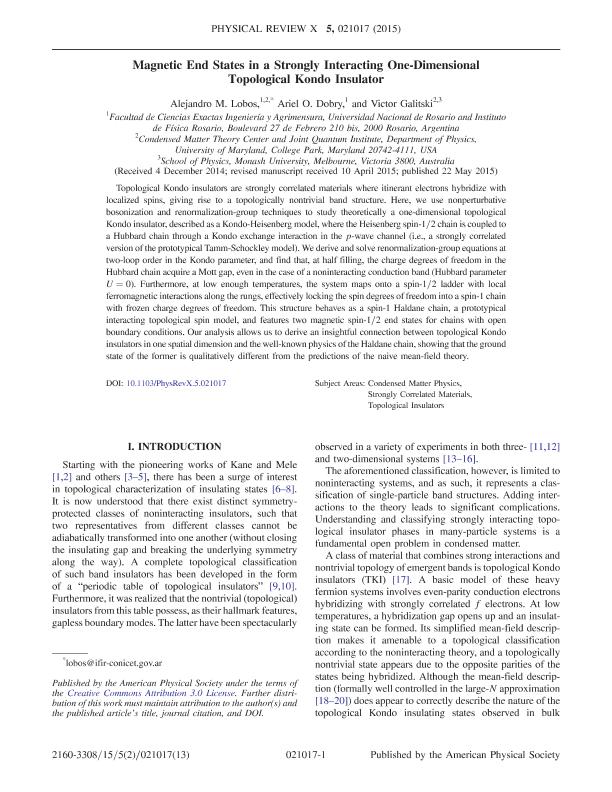Mostrar el registro sencillo del ítem
dc.contributor.author
Lobos, Alejandro Martin

dc.contributor.author
Dobry, Ariel Oscar

dc.contributor.author
Galitski, Victor
dc.date.available
2016-06-09T21:45:33Z
dc.date.issued
2015-05
dc.identifier.citation
Lobos, Alejandro Martin; Dobry, Ariel Oscar; Galitski, Victor; Magnetic End States in a Strongly Interacting One-Dimensional Topological Kondo Insulator; American Physical Society; Physical Review X; 5; 2; 5-2015; 21017-21030
dc.identifier.issn
2160-3308
dc.identifier.uri
http://hdl.handle.net/11336/6149
dc.description.abstract
Topological Kondo insulators are strongly correlated materials where itinerant electrons hybridize with localized spins, giving rise to a topologically nontrivial band structure. Here, we use nonperturbative bosonization and renormalization-group techniques to study theoretically a one-dimensional topological Kondo insulator, described as a Kondo-Heisenberg model, where the Heisenberg spin-1/2 chain is coupled to a Hubbard chain through a Kondo exchange interaction in the p-wave channel (i.e., a strongly correlated version of the prototypical Tamm-Schockley model). We derive and solve renormalization-group equations at two-loop order in the Kondo parameter, and find that, at half filling, the charge degrees of freedom in the Hubbard chain acquire a Mott gap, even in the case of a noninteracting conduction band (Hubbard parameter U=0). Furthermore, at low enough temperatures, the system maps onto a spin-1/2 ladder with local ferromagnetic interactions along the rungs, effectively locking the spin degrees of freedom into a spin-1 chain with frozen charge degrees of freedom. This structure behaves as a spin-1 Haldane chain, a prototypical interacting topological spin model, and features two magnetic spin-1/2 end states for chains with open boundary conditions. Our analysis allows us to derive an insightful connection between topological Kondo insulators in one spatial dimension and the well-known physics of the Haldane chain, showing that the ground state of the former is qualitatively different from the predictions of the naive mean-field theory.
dc.format
application/pdf
dc.language.iso
eng
dc.publisher
American Physical Society

dc.rights
info:eu-repo/semantics/openAccess
dc.rights.uri
https://creativecommons.org/licenses/by/2.5/ar/
dc.subject
Aislantes Topologicos
dc.subject
Sistemas Fuertemente Correlacionados
dc.subject
Fase de Haldane
dc.subject
Cadenas de Espin
dc.subject.classification
Física de los Materiales Condensados

dc.subject.classification
Ciencias Físicas

dc.subject.classification
CIENCIAS NATURALES Y EXACTAS

dc.title
Magnetic End States in a Strongly Interacting One-Dimensional Topological Kondo Insulator
dc.type
info:eu-repo/semantics/article
dc.type
info:ar-repo/semantics/artículo
dc.type
info:eu-repo/semantics/publishedVersion
dc.date.updated
2016-06-01T13:47:51Z
dc.journal.volume
5
dc.journal.number
2
dc.journal.pagination
21017-21030
dc.journal.pais
Estados Unidos

dc.journal.ciudad
College Park
dc.description.fil
Fil: Lobos, Alejandro Martin. Consejo Nacional de Investigaciones Científicas y Técnicas. Centro Científico Tecnológico Rosario. Instituto de Física de Rosario (i); Argentina. Universidad Nacional de Rosario. Facultad de Ciencias Exactas, Ingeniería y Agrimensura; Argentina. University of Maryland; Estados Unidos
dc.description.fil
Fil: Dobry, Ariel Oscar. Consejo Nacional de Investigaciones Científicas y Técnicas. Centro Científico Tecnológico Rosario. Instituto de Física de Rosario (i); Argentina. Universidad Nacional de Rosario. Facultad de Ciencias Exactas, Ingeniería y Agrimensura; Argentina
dc.description.fil
Fil: Galitski, Victor. University of Maryland; Estados Unidos. Monash University; Australia
dc.journal.title
Physical Review X
dc.relation.alternativeid
info:eu-repo/semantics/altIdentifier/ark/http://journals.aps.org/prx/abstract/10.1103/PhysRevX.5.021017
dc.relation.alternativeid
info:eu-repo/semantics/altIdentifier/doi/http://dx.doi.org/10.1103/PhysRevX.5.021017
Archivos asociados
